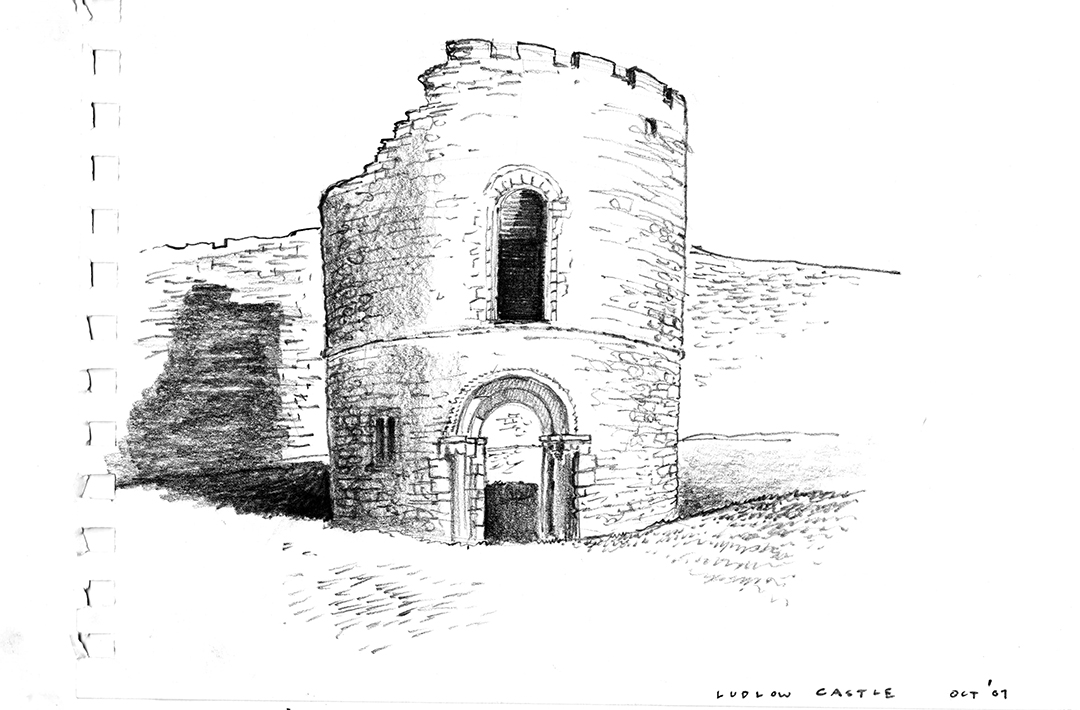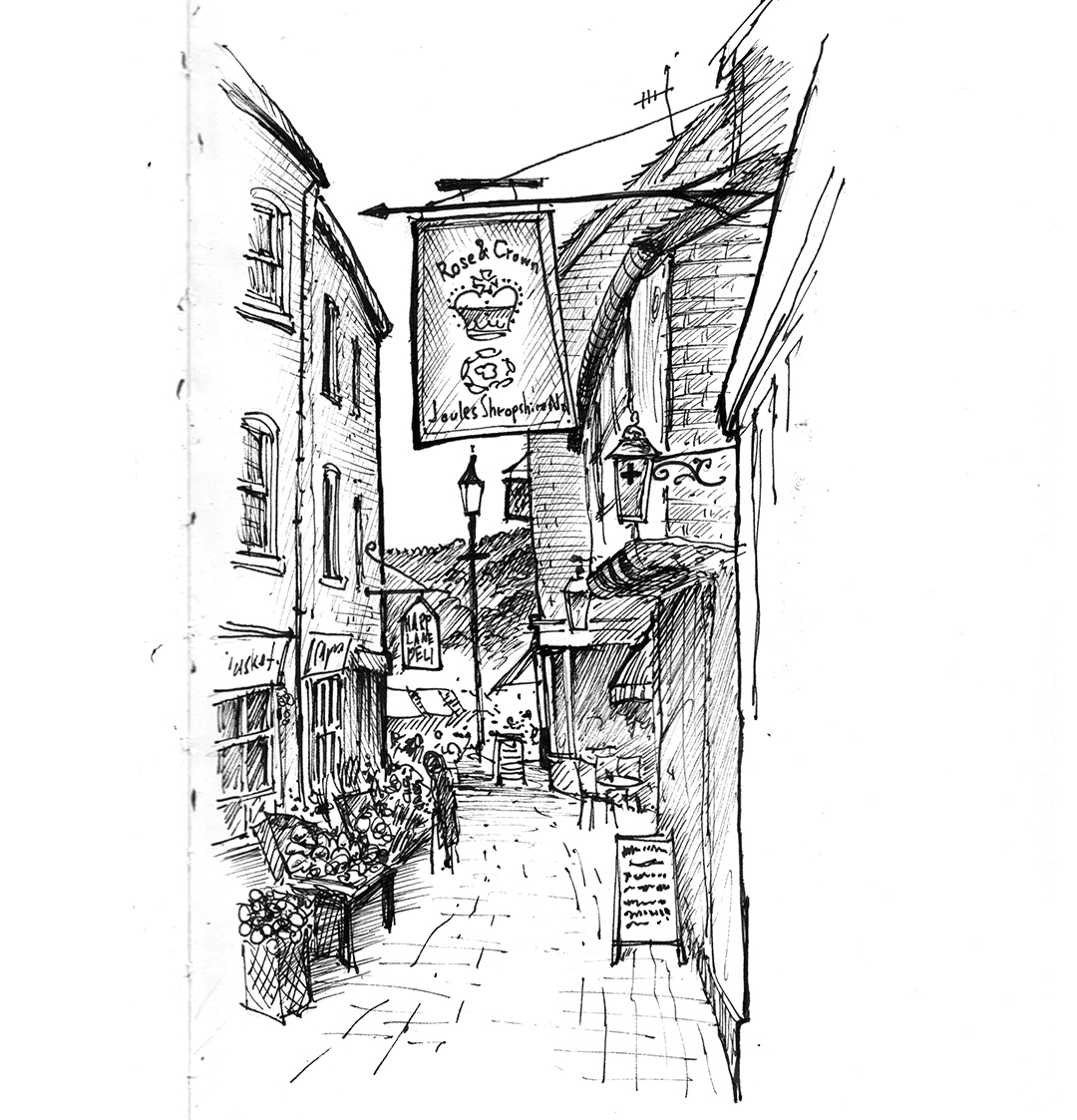In Focus: The joy of sketch — or how drawing beats snapping pictures with your smartphone
Artist and designer David Gillett takes photographs, just like the rest of us — but he also never travels without his sketch pad.


Ludlow, the Shropshire market town dubbed ‘the loveliest town in England’ by Sir John Betjeman, has it all: the curving embrace of the River Teme, a brooding medieval castle, a concentration of some 500 listed buildings, delectable food shops and a glorious church accessed by an alleyway of ancient pubs.
I go there often, but by way of a little black sketchbook, rather than in person. I open a page and I’m back at the Harp Lane Deli: I remember the weather that day (sunny), the noise of the market behind me (bustling) and the Yorkshire terrier inspecting my foot (somehow both nosy and dismissive).
Drawing is to photography what walking is to driving: it’s more work, it’s slower, it demands patience and it’s something we’ve increasingly forgotten how to do. Yet it pays dividends: the work is the reward, the pace allows a scene to sink in and be appreciated. Concentration breeds a contemplative mind set and it’s something that can be re-learned. Anyone can draw, and the more you do it, the more you’ll want to.
I always travel with a camera, but, with my Luddite love of drawing en plein air, the distractions drop exponentially. It’s likely that more photographs have been shot in the past year than in the whole first century of photography: we all carry cameras in our pockets now. However, after posting a few selfies, we go tumbling down the rabbit hole once more, scrolling our way to a world of worry far from the Georgian streetscapes we’ve travelled three hours to enjoy.
As Sherlock said to Dr Watson: ‘You see, but you do not observe. The distinction is clear.’ To sketch a scene is to truly observe it. There is a visceral muscle-and-nerve connection when your mind observes a shape and tells your hand how to bring it to a blank page. There’s a pleasure in it that gives the intellectual imprint depth and substance.

The wide net of digital point-and-shoot is, by contrast, largely a glancing surface treatment and the real work is left to the camera. To sketch a scene challenges our notions of what really matters, as we move through a medieval alleyway or capture a basket of Herefordshire russets in the market square.
Drawing a single line on a fresh page puts everything back in perspective — it’s only me and the richness of the Ludlow streetscape: the signage for the Rose & Crown pub, with its deed dating from 1102; the circular nave of the chapel in the crumbling castle courtyard on a promontory high above the river; the ordered façade of 18th-century Dinham House, surely Britain’s most elegant fireplace shop and once home to Lucien Bonaparte, under house arrest in 1811; or the Michelin-starred restaurant, Old Downton Lodge, its 13th-century timber dining room surreptitiously drawn between two of the nine courses on the exquisite tasting menu.
Sign up for the Country Life Newsletter
Exquisite houses, the beauty of Nature, and how to get the most from your life, straight to your inbox.
Sketching in situ can be loose and, well, sketchy. Quick doodles when waiting for my wife to pick out the perfect Shropshire blue from The Mousetrap Cheese Shop beat careful draughtsmanship for character and soul. Drawing food, perhaps at the table on a sunny morning at Cicchetti on Broad Street (try the omelette with a macchiato), is an excellent way to impress a tasty memory upon a groggy brain — I’ll remember what to order next time.

Those first few tries at street art (cue curious stares from complete strangers) will quickly inoculate you against any hint of embarrassment. I met Ludlow conservation architect Trevor Hewett this way, when I was sketching a finely proportioned Broad Street house next to his office. I was soon going through his books of travel sketches and reminiscing about studying architectural drawing in the pre-computer drafting era. Although we grudgingly accept the value of digital design, we had wistful words for an art that is on life support in our profession.
As The Prince of Wales, a champion of traditional skills, observes: ‘As technology advances at an alarming pace, the place of drawing remains as valid as ever in the creation of art and architecture.’
Also, I might add, in the creation of vivid memories as we travel and observe the world around us — nosy terriers and all.
David Gillett designs country houses and boathouses in Canada. See his sketches on Instagram @davidgillettcanada
Country Life is unlike any other magazine: the only glossy weekly on the newsstand and the only magazine that has been guest-edited by HRH The King not once, but twice. It is a celebration of modern rural life and all its diverse joys and pleasures — that was first published in Queen Victoria's Diamond Jubilee year. Our eclectic mixture of witty and informative content — from the most up-to-date property news and commentary and a coveted glimpse inside some of the UK's best houses and gardens, to gardening, the arts and interior design, written by experts in their field — still cannot be found in print or online, anywhere else.
-
 Six rural properties with space, charm and endless views, as seen in Country Life
Six rural properties with space, charm and endless views, as seen in Country LifeWe take a look at some of the best houses to come to the market via Country Life in the past week.
By Toby Keel
-
 Exploring the countryside is essential for our wellbeing, but Right to Roam is going backwards
Exploring the countryside is essential for our wellbeing, but Right to Roam is going backwardsCampaigners in England often point to Scotland as an example of how brilliantly Right to Roam works, but it's not all it's cracked up to be, says Patrick Galbraith.
By Patrick Galbraith